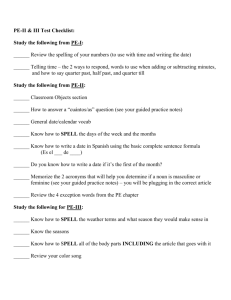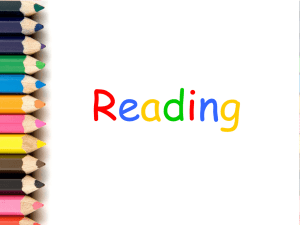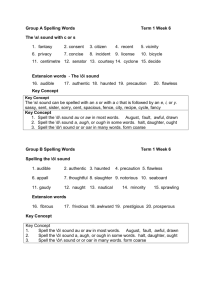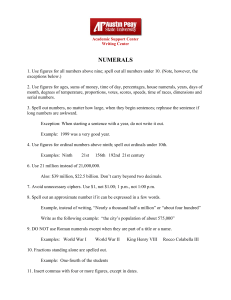Making Sight Words STICK!
advertisement
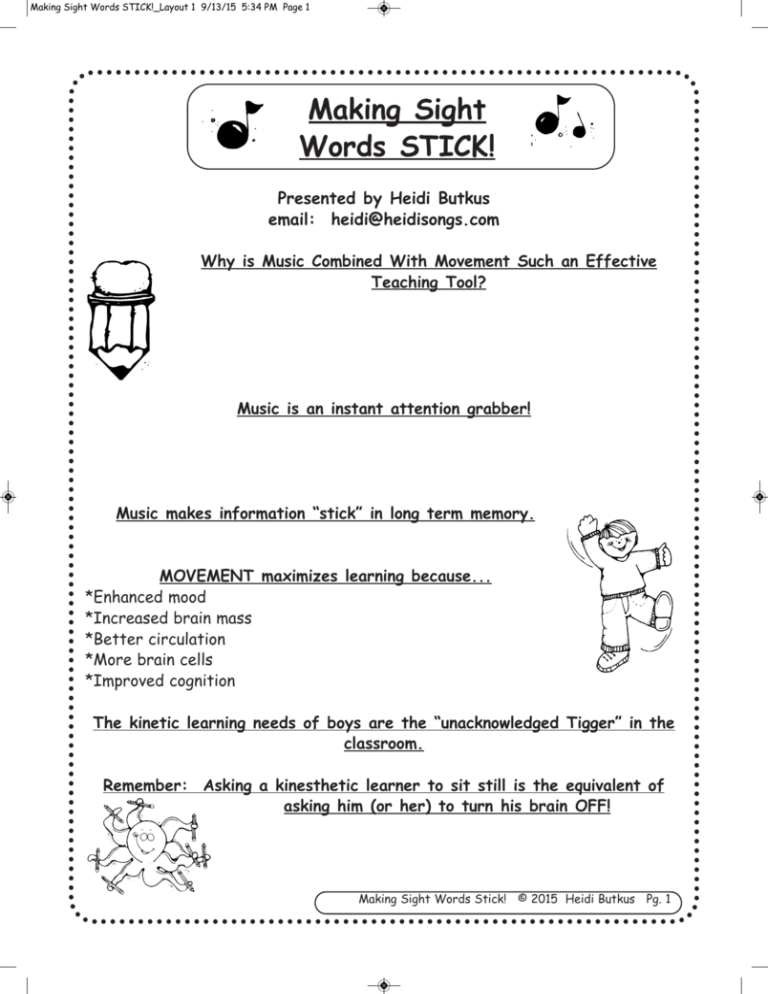
Making Sight Words STICK!_Layout 1 9/13/15 5:34 PM Page 1 Making Sight Words STICK! Presented by Heidi Butkus email: heidi@heidisongs.com Why is Music Combined With Movement Such an Effective Teaching Tool? Music is an instant attention grabber! Music makes information “stick” in long term memory. MOVEMENT maximizes learning because... *Enhanced mood *Increased brain mass *Better circulation *More brain cells *Improved cognition The kinetic learning needs of boys are the “unacknowledged Tigger” in the classroom. Remember: Asking a kinesthetic learner to sit still is the equivalent of asking him (or her) to turn his brain OFF! Making Sight Words Stick! © 2015 Heidi Butkus Pg. 1 Making Sight Words STICK!_Layout 1 9/13/15 5:34 PM Page 2 Sing and Spell the Sight Words And (Sounds like “My Hand on My Head”) Oh, I can spell “and-” A-N-D “and.” “And” is the word that I write with my hand! A-N-D, A-N-D, Nicky, Nicky Noo! That’s what I learned in my school, Mama! Can (Sounds like “Are You Sleeping?”) I can spell “can,” I can spell “can,” C-A-N, C-A-N! I can write the letters- always getting better, C-A-N, C-A-N. Go (Sounds like “Who Did Swallow Jonah?”) G-O, G-O, G-O, G-O, I can spell a “go,” “go,” “go,” “go.” G-O, G-O, G-OG-O, G-O, G-O, “Go,” “go,” “go,” “go,” “go” to school! Is (Sounds like “Hey, Lolly”) I spell “is” I-S, I-S, It doesn’t have a “Z!” I spell “is” I-S, I-S. There’s just no foolin’ me! Like (Sounds like “This Old Man”) I like you, you like me, I spell “like” L-I-K-E! With a great big hug and a kiss from you to me! I spell “like” L-I-K-E. Oh, my, my, my! Come (Sounds like “Little Liza Jane”) Come, little Liza, C-O-M-E! Come, little Liza, C-O-M-E! Come, little Liza, C-O-M-E! Come, little Liza, C-O-M-E! Come and play everyday! Come play with me! Come and play everyday! Come play with me! (Available at www.heidisongs.com) Some (Pease Porridge Hot) Some play with you, Some play with me. I write “some” S-O-M-E! (repeat 3 more times with increasing speed) All (Ring Around the Rosie) A-L-L spells all! A-L-L spells all! All, all! We all fall down! Made (Tooty Ta) M-A-D-E, M-A-D-E, I can spell “Made!” M-A-D-E, M-A-D-E, I can spell “Made!” Thumbs up, Elbows back! Feet apart, Knees together! M-A-D-E, M-A-D-E, I can spell “Made!” M-A-D-E, M-A-D-E, I can spell “Made!” Thumbs up, Elbows back! Feet apart, Knees together! Bottoms up, Tongue out! Eyes closed, Turn around! M-A-D-E, M-A-D-E, I can spell “Made!” M-A-D-E, M-A-D-E, I can spell “Made!” Making Sight Words Stick! © 2015 Heidi Butkus Pg. 2 Making Sight Words STICK!_Layout 1 9/13/15 5:34 PM Page 3 Now (Little Red Caboose) N-O-W! N-O-W! Now it’s time to get on the caboose. Toot, toot! N-O-W! N-O-W! Now it’s time to get on the caboose. Toot, toot! Yellow sun and banana, too. Y-E-L-L-O-W! Yellow sun and banana, too. Y-E-L-L-O-W! Yellow! Yellow! Y-E-L-L-O-W, Yellow! Yellow! Y-E-L-L-O-W! Black (Sounds like “Peer Gynt Suite”) In (Sounds like “Michael Finnegan”) I, then N, can you spell in again? I, then N, can you spell in again? I, then N, can you spell in again? Take it our and put it in, begin again! Green (Sounds like “The Witch Doctor”) G-R-E-E-N, Green as a little leprechaun is, G-R-E-E-N, A fat caterpillar is green! B-L-A-C-K spells black! Flying bat, pointy hat! Black as night without a light! B-L-A-C-K. Black! The (Sounds like “Hot Cross Buns”) T-H-E, T-H-E! I can spell “the:” T-H-E! You can download all hand-motions free online at www.heidisongs.com, along with the words White (Sounds like “Mrs. White Had a Fright”) White as snow, marshmallow, W-H-I-T-E, Polar bear, underwear, W-H-I-T-E! Blue to all songs and a reference to the traditional tune, Modeled Writing Lesson Using Spelling Songs as a Tool Notes (Sounds like “Mary Had a Little Lamb”) B-L-U-E, that spells blue! Ocean blue, sky blue too! B-L-U-E, that spells blue! Raindrop blue! Yellow (Sounds like “Day-O”) Yellow! Yellow! Y-E-L-L-O-W, Yellow! Yellow! Y-E-L-L-O-W! Making Sight Words Stick! © 2015 Heidi Butkus Pg. 3 Making Sight Words STICK!_Layout 1 9/13/15 5:34 PM Page 4 More Ways to Practice Sight Words Notes Making Sight Words Stick! © 2015 Heidi Butkus Pg. 4 Making Sight Words STICK!_Layout 1 9/13/15 5:34 PM Page 5 Helpful Hints for Using Sing and Spell 1. To maximize results, introduce just one or two songs a week for younger Kindergartners. You can pick pu the pace to three to four new spelling songs per week during the second half of the school year, if your students are keeping up. You can increase the number of word songs introduced per week for older children. 2. Practice getting your children to calm down when you are done singing. Demonstrate the behavior you expect, and practice it with the children before you begin. 3. Always include hand motions of some kind. This keeps the children motivated and engaged. 4. Once the children know the songs, have them sit and write the words as you sing them. I use individual white boards for the children to write on. 5. Always show the word when you introduce a song. Have the children spell it aloud with you as you point to the letters. 6. Use the songs as a classroom management tool. If your students are getting restless, have them stand and sing a song with movements. They can get their wiggles out AND learn at the same time. They can also be used for review during those “unteachable” transition times. 7. Demonstrate how to write sentences, using the songs as a spelling tool. Explicitly teach what the songs can be used for. 8. Use a word wall. Some kids can repeat the spellings but not visualize the word. Have them sing the song aloud, and then find the word on the wall to copy it. 9. If you are not comfortable with any of the motions, change them! Make it so that you and your students like it. 10. What should we do with kids that are reluctant to participate? Do everything you can to nip it in the bud! * Explain that we are learning through this activity. Refusing to sing and/or move is the same as refusing to do a worksheet. * Settle on a consequence and stick with it. * Get parents to help with "non-participants." Explain that passive children learn more slowly. * Move "class leaders" that participate near the front, and reluctant children to the back. Follow me! Twitter: @heidisongs Google+: Heidi Butkus Facebook: HeidiSongs Pinterest: Heidi Songs Blog: www.heidisongs.com/blog YouTube: HeidiSongs Questions? email: heidi@heidisongs.com website: www.heidisongs.com Making Sight Words Stick! © 2015 Heidi Butkus Pg. 5 Making Sight Words STICK!_Layout 1 9/13/15 5:34 PM Page 6 List of Related Citations Presented by Heidi Butkus Gardner, H. (1983). Frames of Mind: The Theory of Multiple Intelligences. New York: Basic Books. Jensen, E. (1998). Teaching with the Brain in Mind. Alexandria, VA: ASCD. Hannaford, C. & Pert, C. (2005). Smart Moves: Why Learning Is Not All in Your Head. Stoddard, WI Great River Books. Mah, R. (2007). Difficult Behavior in Early Childhood: Positive Discipline for PreK-3 Classrooms and Beyond. Thousand Oaks, CA: Corwin Press. Marzano, R., Pickering, J. & Pollock, J. (2001). Classroom Instruction That Works: Research-Based Strategies for Increasing Student Achievement, Alexandria, VA: ASCD. Marzano, R. (2004). Building Background Knowledge for Academic Achievement: Research on What Works in Schools, Alexandria, VA: ASCD Tate, M. ((2007). Shouting Won’t Grow Dendrites: 20 Techniques for Managing a Brain-Compatible Classroom. Thousand Oaks, CA: Corwin Press. Making Sight Words Stick! © 2015 Heidi Butkus Pg. 6


